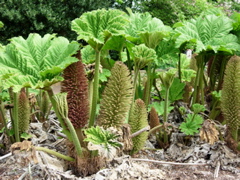Gardeners’ stockings are soon to be filled with Atlas gloves, trowels, sisal twine and bird netting, but those of us who also enjoy traveling to garden may have a few other items on our minds.
The garden traveler’s holiday wish list is a hybrid of sorts – somewhere between a normal tourist and a gardener.
A tour – Cough up the bucks and send your garden traveler (or yourself) on a specialty tour with like-minded people, who want to discuss the merits of Crinodendron hookerianum and where it will grow. Our Ireland tour for 2010 may be just the ticket.
Crinodendron hookerianum and where it will grow. Our Ireland tour for 2010 may be just the ticket.
A digital camera – And not just any cheap or any expensive model. We take pictures outside and so we need more than a 2.5- or 3-inch LCD screen on the back of the camera: We need a viewfinder. Call it old-fashioned, but in bright daylight those screens are useless. Canon has some reasonably priced models that all include viewfinders; check out the SD780IS. Yes, we do need that image stabilizer – this isn’t a professional photographers tour, and we won’t wait around while you set up your fancy equipment. Anyway, many gardens have a “no tripod” rule, and so we must be our own tripods.
Something to write on – Garden travelers take notes. We may need to jot down the name of a plant or something funny that our local guide says (“The crowd will be heaving.”) And occasionally, we may need to write that down in middle of a light mist. So, a Rite-in-the-Rain notebook comes in handy. They come in all

Leighton's beer notebook
sizes and have yellow covers. Leighton has a small one that he uses as his beer notebook; you never know when a splash of a best bitter might land on an important comment. Rite-in-the-Rain also carries pencils for wet-weather use.
A raincoat, not an umbrella – See previous entry on my biases.
A travel purse – I’ve found mine, it’s a Baggalini. Wide strap to go over my shoulder, enough but not too many zipper pockets and loads of room even though it looks small. Waterproof for those less-than-perfect weather days.
Really good walking shoes – We are not hikers; or at least, this is not a hiking trip. Shoes are too personal to recommend, but I’ll tell you I love my new Clarks Unstructured. Take two pairs so that they can get a rest every other day.
Books about the gardens you want to see – Patrick Taylor’s book The Gardens of Britain and Ireland will give you a good overview. The Good Gardens Guide by Peter King usually comes out every year. Is there a particular place you want to read about? Ask me for a recommendation.
And, for those lovers of English ale, Leighton recommends The Good Beer Guide – which brews are the best and where to find them. To get the 2010 edition, you must go to the amazon UK site.
See you in the garden. Or the pub.



 Cartwright Gardens—and along our short walk to Russell Square and its fabulously restored gardens—we walk along Queen Square. The first time we did this we saw a plaque at 3 Queen Square for
Cartwright Gardens—and along our short walk to Russell Square and its fabulously restored gardens—we walk along Queen Square. The first time we did this we saw a plaque at 3 Queen Square for 

